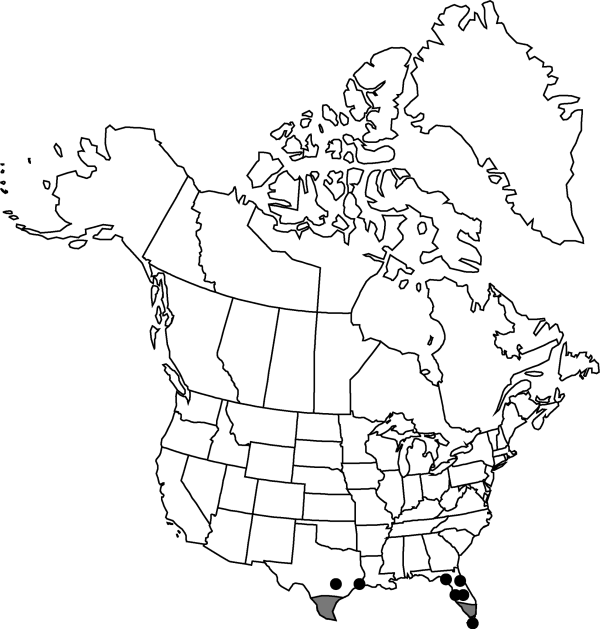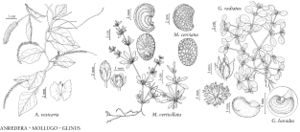Anredera vesicaria
Suppl. Carp., 176. 1807.
Stems twining to 8 m, axillary tubers absent. Leaves: petiole 3–18 mm; blade ovate to elliptic, 2–16 × 0.5–9 cm, base of larger leaves proximal to inflorescence acute to cuneate, apex acute to obtuse. Inflorescences racemes or in branched panicles of racemes, 3–35(–70) cm; single bract subtending each pedicel oblong-oblanceolate, 1–2 × 0.2–0.5 mm; paired bracts subtending each flower deciduous, triangular, 0.6–1 × 0.5–0.8 mm, distinct. Flowers bisexual or functionally unisexual; sepals basally adnate to petals, keeled, becoming winged in fruit, cream-white, elliptic, 1.7–2 × 1–1.3 mm, apex obtuse; petals basally connate, cream-white, elliptic, 1.5–2.3 × 0.8–1.1 mm, apex obtuse, spreading at anthesis; stamens of bisexual and functionally staminate plants fleshy; filaments basally connate and dilated, 2.5–3.8 mm; anthers 0.8–1 mm; stamens of functionally pistillate plants reduced and sterile; pistils in bisexual and functionally pistillate plants 0.4–0.6 mm; styles 0.8–1.5 mm, basally connate 1/3–1/2 their length; stigmas clavate to bifid; pistils of functionally staminate plants reduced; pedicel 1–3 mm. Utricles with style bases persistent, not [rarely] produced in functionally staminate plants, obovoid, 1–1.4 mm.
Phenology: Flowering late summer–fall.
Habitat: Disturbed areas, fencerows, roadsides, thickets
Elevation: 0-500 m
Distribution

Fla., Tex., Mexico, West Indies, Central America, South America, Eurasia, Africa, Pacific Islands, Australia.
Discussion
Anredera vesicaria as treated here has two morphologically distinct forms, which C. R. Sperling (1987) considered as functionally staminate and functionally pistillate forms of the same species. Functionally pistillate plants (traditional A. vesicaria) apparently do not produce pollen, yet produce fruit. Functionally staminate plants (traditional A. (Boussingaultia) leptostachys) produce pollen, but rarely produce fruit. Both forms produce tubers at the base of the stem and below ground, and it is the apparent means of reproduction of the staminate plants. Further biosystematic and molecular study of these organisms is warranted to determine whether this treatment is valid.
Anredera vesicaria is cultivated for its showy inflorescences and fragrant flowers (C. R. Sperling 1987).
Selected References
None.
